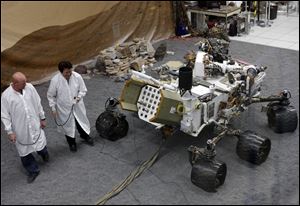
Rover Curiosity sticks the landing but work on Mars has just begun
8/7/2012
Engineers work on a model of the Mars rover Curiosity at the Spacecraft Assembly Facility at NASA's Jet Propulsion Laboratory in Pasadena, Calif.
PASADENA, Calif. -- With the Mars rover Curiosity's dramatic landing accomplished, testing of its communication and power systems began Monday as NASA worked to understand exactly where its vehicle had landed and how well it had withstood its 354 million-mile journey to Mars.
NASA scientists believe the one-ton rover landed on bedrock in the 3.5 billion-year-old Gale Crater and is facing the distant crater wall, believed to be about three miles high.
A mountain in the crater will be the focus of the mission because its exposed rock faces are expected to provide clues about the area's physical history and whether life's building blocks ever existed there.
In the aftermath of the high-precision landing, space-exploration advocates embraced Curiosity as proof of American ambition and prowess.
"If anybody has been harboring doubts about the status of U.S. leadership in space, well, there's a one-ton, automobile-size piece of American ingenuity, and it's sitting on the surface of Mars right now," presidential science adviser John Holdren said after the landing.
Curiosity, called "the mission of the decade" by NASA officials, will search for the building blocks of extraterrestrial life and investigate how Mars turned from a wet and warm planet into a dry and cold one.
The sophisticated instruments used on the mission could hasten the day when humans fly to Mars.
The two-year mission could draw interest for years, inspiring young people to go into science the way the Apollo moon program did in the 1960s and 1970s, officials said.
"Experiencing that remarkably complex but perfect landing, and then watching the rover in the months ahead, can't help but excite young people," said Jean-Lou Chameau, president of the California Institute of Technology, which operates NASA's Jet Propulsion Laboratory. JPL is managing the mission.
President Obama hailed the landing as "an unprecedented feat of technology that will stand as a point of national pride far into the future. It proves that even the longest of odds are no match for our unique blend of ingenuity and determination."
There have been seven successful landings on Mars, all by NASA.
But Curiosity is by far the most technically sophisticated -- and expensive. Its $2.5 billion price tag has drawn some criticism.
But after nailing the most difficult planetary landing ever, NASA and Obama Administration officials appear to believe the dynamic has changed.
After the landing, NASA Administrator Charles Bolden told a cheering crowd that the mission as a whole cost the equivalent of a single movie ticket for everyone in the United States.
"And this is a movie I think people want to see," he said.
Sen. Kay Bailey Hutchison (R., Texas) called the first images "breathtaking."
"The soft landing of the Curiosity rover on Mars is a testament to NASA's engineering superiority," she said.
The landing could not come at a more opportune time for NASA, which is facing significant budget cuts. Some of the largest budget hits are to the Mars and planetary sciences programs, cuts that many now say could and should be scaled back.
The United States now has two active rovers on the planet and two orbiters, a high point for the nation's presence on or around Mars.
While the landing provided high drama and a look at the highest-quality, made-in-America technology and expertise, the mission has only begun.
Scientists will begin their work soon. More than 300 of them gathered at JPL for the landing, as anxious as the engineers about the rover's fate.
Curiosity also will be providing images and videos of a type and quality never seen before.
The first photos were primitive black-and-white fisheye images taken by the hazard cameras at the bottom of the vehicle, used to look for potentially harmful boulders.
But future pictures will be in high-definition color and some will be taken from Mount Sharp -- the three-mile-high mountain in the center of the crater that Curiosity will climb in the months ahead.
The image of Curiosity's descent was taken by the High Resolution Imaging Science Experiment camera aboard NASA's Mars Reconnaissance Orbiter.
In the photo, the Curiosity rover was still connected to its 51-foot-wide parachute as it descended toward its landing site at Gale Crater.
At a news conference Monday, mission manager Mike Watkins said "we are a 'go' for all plans" for first-day activities. He described them as "kind of boring," including system checks to make sure the rover is fully operational.
The first order of business: making sure communications back to Earth are healthy.